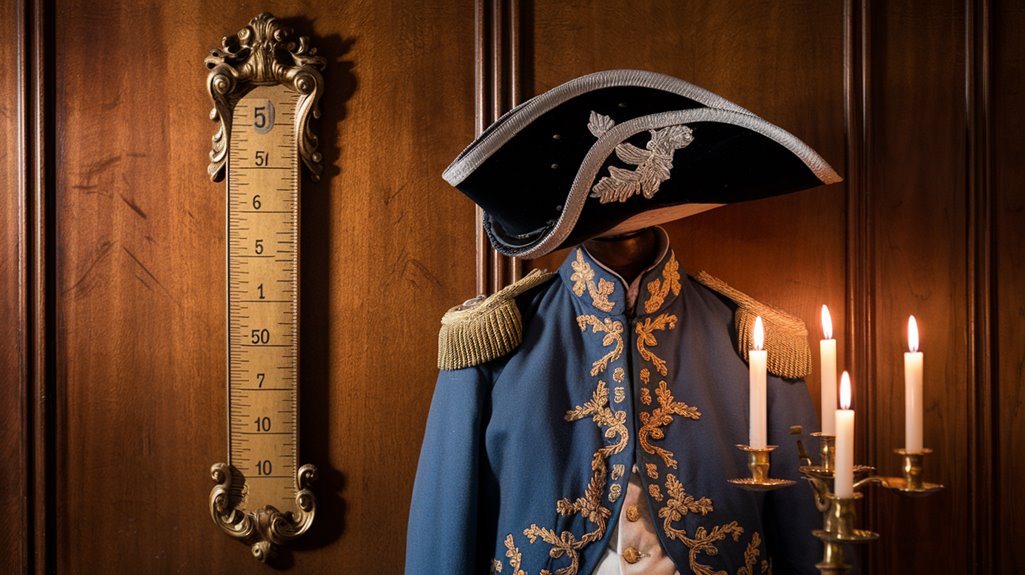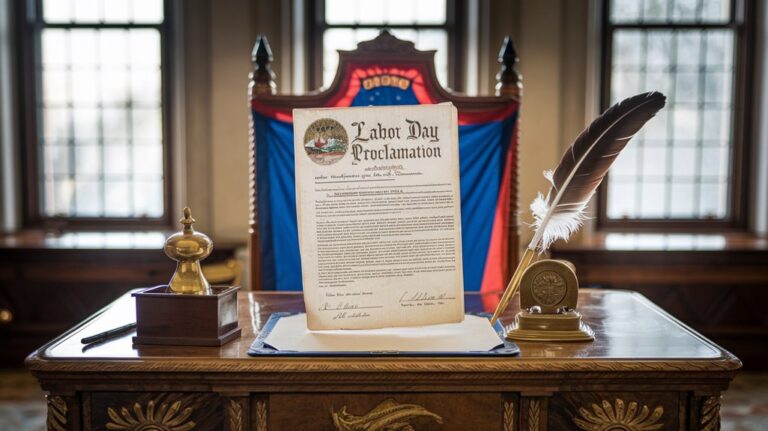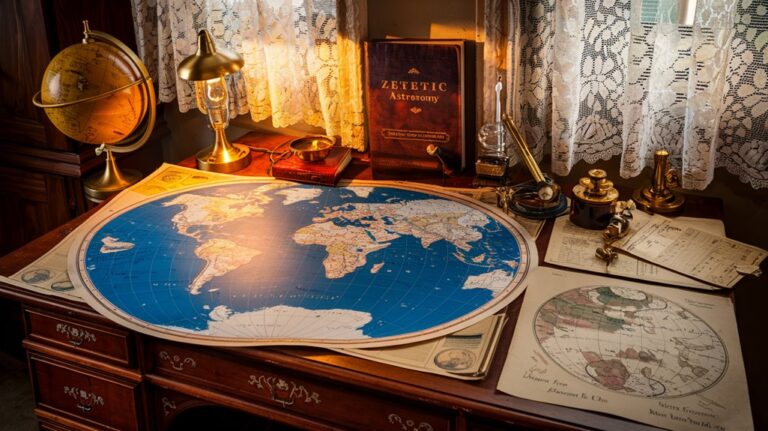Napoleon Was Actually Average Height for His Time
When you look at the famous Jacques-Louis David painting of Napoleon crossing the Alps, you'll notice he's portrayed as a commanding figure of substantial presence. Yet for centuries, you've probably heard jokes and references to Napoleon being extremely short. This enduring misconception has shaped popular culture's view of the French emperor, but the truth about his physical stature reveals a fascinating story of how historical propaganda can distort reality for generations to come.
The Origin of Napoleon's Height Myth
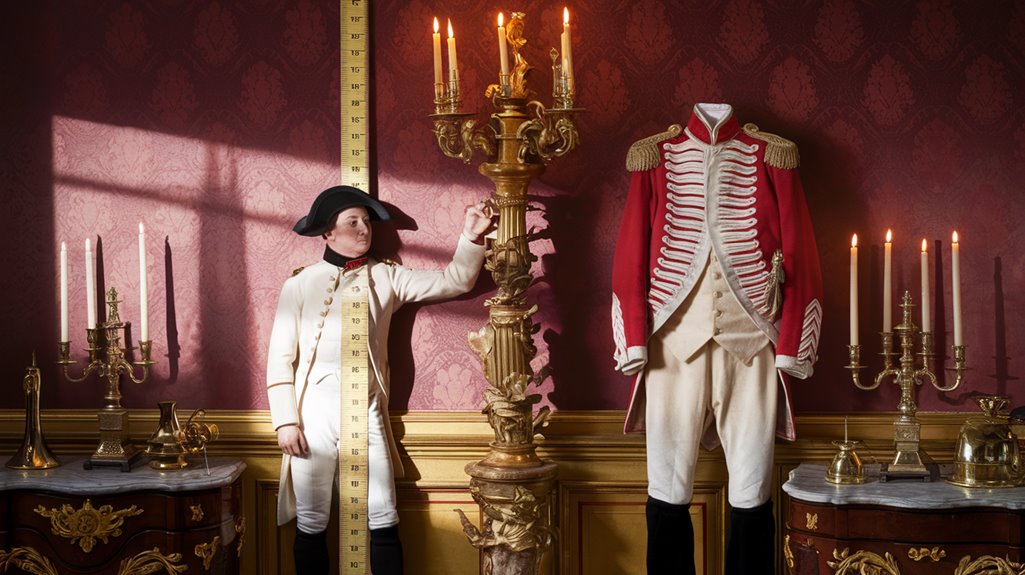
Gillray's caricatures portrayed Napoleon as a diminutive, childish figure, mocking both his physical appearance and his expansionist ambitions.
The widespread circulation of these images throughout Britain had a lasting impact on public perception. His frequent appearance among Imperial Guard soldiers, who had strict height requirements for service, further contributed to the illusion of his small stature.
You might be surprised to learn that Napoleon was actually 5 feet 7 inches tall, which was average height for his time period.
You might be surprised to learn that Napoleon was so troubled by these depictions that he attempted to pressure the British government to censor them.
He even claimed that Gillray's caricature influence had done more damage to his reputation than all of Europe's armies combined.
Understanding French Vs British Measurement Systems
The widespread misunderstanding of Napoleon's height stems largely from the complex differences between French and British measurement systems of the era.
If you'd lived in pre-revolutionary France, you'd have encountered a measurement system that varied considerably from town to town, creating widespread confusion and measurement discrepancies. It's estimated that a quarter million units of measurement were in use just before the French Revolution. While the French *pied* (foot) was larger than its British counterpart, most English speakers today aren't aware of these historical standards.
When you hear that Napoleon was 5'2", you're likely thinking in British measurements. However, in French units of the time, this equated to roughly 168-170 centimeters (5'6" in modern measurements). British propaganda efforts played a significant role in portraying Napoleon as a small man to undermine his authority.
This difference in measurement systems, combined with the lack of standardization before the metric system's introduction in 1795, has contributed to centuries of misunderstanding about Napoleon's actual height.
Napoleon's True Height in Modern Terms
Despite centuries of mischaracterization, historical records conclusively show that Napoleon stood approximately 168-170 centimeters (5'6"-5'7") tall, making him average or slightly above average height for his era.
When you examine Napoleon's stature in historical context, you'll find multiple reliable sources confirming his height. His death certificate and contemporary accounts from his valet and General Montholon all support these measurements. He often appeared shorter because he was frequently pictured alongside his Grenadiers of the Guard, who had to be at least 1.76 meters tall. English propaganda played a significant role in spreading the myth of his short stature.
The average French male of his time stood around 1.60 meters, while infantry conscripts typically measured between 1.65 and 1.69 meters. This means Napoleon wasn't short at all – he was either average or slightly taller than many of his countrymen.
The "Little Corporal" nickname that contributed to misconceptions about his height was actually a term of endearment from his soldiers.
British Propaganda's Role in the Short Emperor Story
British political cartoonists played a masterful role in creating the enduring myth of Napoleon's short stature. Through strategic propaganda techniques, artists like James Gillray and Isaac Cruikshank depicted "Little Boney" as a diminutive, temperamental figure, exploiting cultural stereotypes to undermine his authority. Napoleon himself admitted that Gillray's satirical works were more damaging than defeats in battle. At 5 feet 7 inches tall, Napoleon was actually of typical height for a Frenchman of his era.
You'll find these key elements in Britain's successful campaign to diminish Napoleon's image:
- Deliberate misrepresentation of French measurement units to exaggerate height differences
- Strategic placement of Napoleon next to his taller Imperial Guard in illustrations
- Manipulation of his nickname "Le Petit Corporal," though it was actually a term of endearment
- Widespread distribution of satirical cartoons portraying him as childish and short-tempered
This propaganda campaign was so effective that it's influenced public perception for centuries, despite historical evidence showing Napoleon was of average height for his era.
Average Heights of European Men in the 1800s
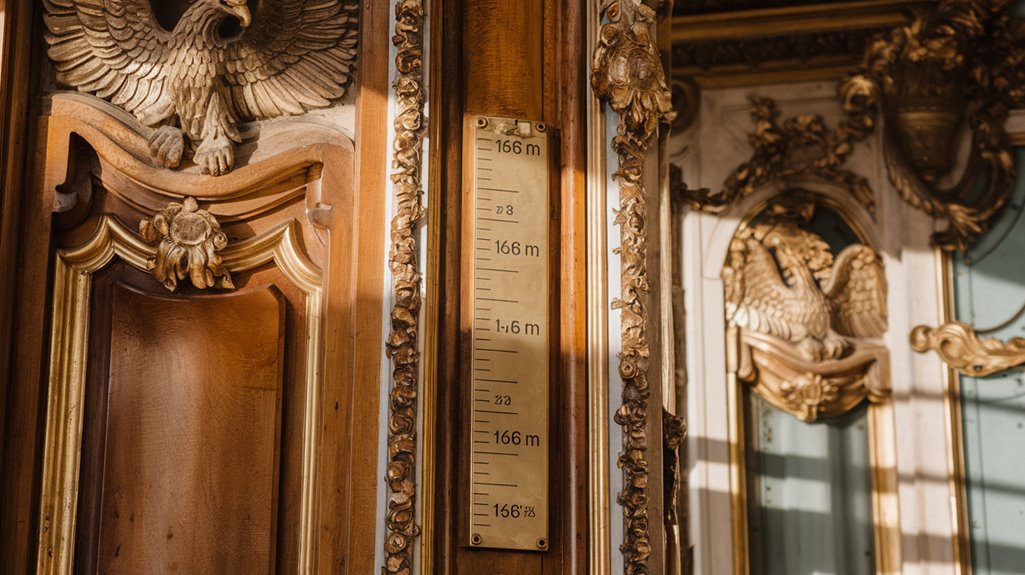
While modern audiences might consider 18th-century European men short by today's standards, historical records reveal fascinating patterns in human height across the continent.
When making height comparisons, you'll find that European men in the 1700s averaged between 64.5 and 66 inches (164-168 cm). Irish and Hungarian men were particularly taller due to better agricultural conditions and nutrition. Based on historical accounts, Napoleon's actual height fell right within this average range.
You can see clear nutritional impacts on height throughout this period. Men's stature had actually declined from the Early Middle Ages, when they averaged 68.27 inches (173.4 cm). This drop of about 2.5 inches wouldn't recover until the 20th century.
Climate change, increasing urbanization, and shifts in farming practices all played roles in these height fluctuations, particularly affecting agricultural populations differently than urban dwellers. The warm climate period between 900-1300 CE was especially beneficial for crop yields and overall nutrition.
Historical Evidence That Debunks the Short Napoleon Legend
For centuries, the myth of Napoleon's diminutive stature has persisted in popular culture, yet historical evidence tells a different story.
Multiple historical records debunk these historical misconceptions, revealing how British propaganda tactics deliberately misrepresented his height. You'll find that Napoleon actually stood around 5'6" tall, which was average for his time period. British caricatures played a significant role in spreading this misconception through exaggerated satirical drawings. The perception of his short stature was enhanced by his tendency to surround himself with tall personal guards.
Key evidence that dispels the short Napoleon legend:
- Military records show the average height of French soldiers matched Napoleon's stature.
- Napoleon's personal valet and General Montholon confirmed his height as approximately 5'6".
- French measurement systems of the era recorded him as 5'2", which converts to 5'6" in modern English measurements.
- Scholarly research and reliable biographies consistently document his height between 5'6" and 5'7".
You've been misled by centuries of effective propaganda that turned a measurement difference into a lasting historical myth.




